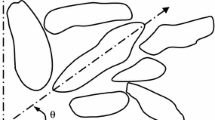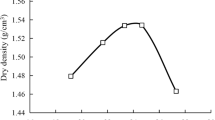Abstract
Compaction is a common soil improvement technique that is used in geotechnical engineering applications to reduce permeability. The size, shape, and distribution of soil particles and pores are altered during this process. Soil fabric refers to the size, shape, and distribution of particles and pores in the soil, and it has a direct impact on permeability, which is an important engineering parameter of soils. The study’s novelty utilized the permeability coefficient in three directions to evaluate the orientation degrees of the mixed clayey mica schist soil and fly ash particles (void, grain, and other components) compacted into the cube-shaped volume at the optimum water content. Thin-section analysis of cubic soil samples revealed that permeability was influenced not only by the shape, size, and distribution of particles and pores in the soil fabric but also by their orientation angles. While the compression direction of the clayey soil had the lowest permeability coefficient of 2.9 × 10–8 m/s, the other two directions had permeability coefficients of 7.0 × 10–8 m/s and 7.2 × 10–8 m/s, respectively. Because there is no orientation effect in all three directions, fly ash has the highest permeability coefficient of 2.25 × 10–7 m/s.













Similar content being viewed by others
References
Alam J, Muzzammil M, Singh HP, Gupta P (2015) Permeability of stratified soils for flow normal to bedding plane. Aquat Procedia 4:660–667. https://doi.org/10.1016/j.aqpro.2015.02.085
ASTM D 2434-68 (2003) Standard test method for permeability of granular soils (constant head). American Society For Testing and Materials, West Conshohocken, PA, pp 233–237
ASTM D 422-63 (2003) Standard test method for particle-size analysis of soils. Annual Book of ASTM Standards. American Society For Testing and Materials, West Conshohocken, PA, pp 10–17
ASTM D 4318-00 (2003) Standard test methods for liquid limit, plastic limit and plasticity index of soils. Annual Book of ASTM Standards. American Society For Testing and Materials, West Conshohocken, PA, pp 582–593
ASTM D 698-00a (2003) Standard test method for laboratory compaction characteristics of soil using standard effort. Annual Book of ASTM Standards. American Society For Testing and Materials, West Conshohocken, PA, pp78–87
Barton C (1974) The micromorphological soil-investigation work of Dr. Lafeber, Soil micro. The Limestone Press, Kingston
Cetin H (1998) Soil-pore and particle orientations caused by active faulting: a soil micromorphological perspective. Soil Sci 163:374–381
Cetin H (2000) An experimental study of soil memory and preconsolidation adjacent to an active tectonic structure: the Meers Fault, Oklahoma, USA. Eng Geol 57:169–178. https://doi.org/10.1016/S0013-7952(00)00026-0
Cetin H, Söylemez M (2004) Soil-particle and pore orientations during drained and undrained shear of a cohesive sandy silt–clay soil. Can Geotech J 41:1127–1138. https://doi.org/10.1139/t04-055
Cetin H, Fener M, Söylemez M, Günaydin O (2007) Soil structure changes during compaction of a cohesive soil. Eng Geol. https://doi.org/10.1016/j.enggeo.2007.03.005
Chandler R (1973) A study of structural discontinuities in stiff clays using a polarizing microscope. In: Proceedings of the international symposium on soil structure. Gothenburg Swedish Geotechnical Society & Swedish Society for Clay Research, Stockholm, Sweden, pp 78–85
Chen XB, Li ZY, Zhang JS (2014) Effect of granite gravel content on improved granular mixtures as railway subgrade fillings. J Cent South Univ 21:3361–3369. https://doi.org/10.1007/s11771-014-2310-z
Crampton C (1974) Micro shear-fabrics in soils of the Canadian north, Soil micro. The Limestone Press, Kingston
Delage P, Lefebvre G (1984) Study of the structure of a sensitive Champlain clay and of its evolution during consolidation. Can Geotech J 21:21–35. https://doi.org/10.1139/t84-003
Douglas L, Sole-Benet A, Low A, Platt D (1983) The micromorphology of two soil fault-breccias. AB Academic Publishers, Berkhamsted
FitzPatrick E (1993) Soil microscopy and micromorphology. Wiley, Chichester
Garga V (1973) Some observation on micro structure of clays at large strains. Gothenburg Swedish Geotechnical Society & Swedish Society for Clay Research, Stockholm, pp 217–225
Günaydın O, Özbeyaz A, Söylemez M (2018) Regression analysis of soil compaction parameters using support vector method. Celal Bayar Üniversitesi Fen Bilimleri Dergisi 14:443–447. https://doi.org/10.18466/cbayarfbe.449644
Higo Y, Oka F, Kimoto S, Sanagawa T, Matsushima Y (2011) Study of strain localization and microstructural changes in partially saturated sand during triaxial tests using microfocus X-ray CT. Soils Found 51(1):95–111
Holtz RD, Kovacs WD (1981) An introduction to geotechnical engineering. Prentice-Hall Inc, Englewood Cliffs
Holtz RD, Kovacs WD, Sheahan TC (2011) An introduction to geotechnical engineering, 2nd edn. Prentice Hall, Hoboken
Hueckel T, Kaczmarek M, Caramuscio P (2011) Theoretical assessment of fabric and permeability changes in clays affected by organic contaminants. Can Geotech J 34:588–603. https://doi.org/10.1139/t97-013
Kirkpatrick WM, Rennie IA (1972) Directional properties of consolidated Kaolin. Geotechnique 22:166–169. https://doi.org/10.1680/geot.1972.22.1.166
Lambe T (1958) The structure of compacted clay. J Soil Mech Found Div. https://doi.org/10.1061/JSFEAQ.0000114
Liu YF, Jeng DS (2019) Pore scale study of the influence of particle geometry on soil permeability. Adv Water Resour 129:232–249. https://doi.org/10.1016/j.advwatres.2019.05.024
McConnachie I (1974) Fabric changes in consolidated kaolin. Geotechnique 24:207–222. https://doi.org/10.1680/geot.1974.24.2.207
Mitchell J (1993) Fundamentals of soil behavior. Wiley, New York
Morgenstern N, Tchalenko J (1967) Microstructural observations on shear zones from slips in natural clays. In: Proceedings of the geotechnical conference, Norwegian Geotechnical Institute, Oslo, pp 147–152
Onur EM (2014) Predicting the permeability of sandy soils from grain size distributions. Doctoral dissertation, Kent State University
Shafiee A (2008) Permeability of compacted granule–clay mixtures. Eng Geol 97:199–208. https://doi.org/10.1016/j.enggeo.2008.01.002
Skempton AW (1984) The colloidal “activity” of clays. In: Selected papers on soil mechanics, pp 60–64. https://doi.org/10.1680/sposm.02050.0009
Sloane R, Kell T (1966) The fabric of mechanically compacted kaolin. In: Clays and clay minerals. Proceedings of the fourteenth national clay conference, pp 289–296
Sloane R, Nowatzki E (1967) Electron-optical study of fabric changes accompanying shear in a kaolin clay. In: Proceedings of the 3rd Pan-American conference on soil mechanics and foundation engineering, Caracas, pp 215–225
Söylemez M, Yildirim A (2016) Effects of fly ash of thermal power plant on strength of brick. Adıyaman Üniversitesi Mühendislik Bilimleri Dergisi 4:19–31
Veiskarami M, Roshanali L, Habibagahi G (2022) Effect of particles shape on the hydraulic conductivity of Stokesian flow in granular materials. Geotech Geol Eng 40:4645–4656. https://doi.org/10.1007/s10706-022-02175-w
Vogeler I, Carrick S, Cichota R, Lilburne L (2019) Estimation of soil subsurface hydraulic conductivity based on inverse modelling and soil morphology. J Hydrol 574:373–382. https://doi.org/10.1016/j.jhydrol.2019.04.002
Yoshinaka R, Kazama H (1973) Microstructure of compacted kaolin clay. Soils Found 13:19–34
Zhai Q, Rahardjo H, Satyanaga A (2018) A pore-size distribution function based method for estimation of hydraulic properties of sandy soils. Eng Geol 246:288–292. https://doi.org/10.1016/j.enggeo.2018.09.031
Author information
Authors and Affiliations
Corresponding author
Rights and permissions
Springer Nature or its licensor (e.g. a society or other partner) holds exclusive rights to this article under a publishing agreement with the author(s) or other rightsholder(s); author self-archiving of the accepted manuscript version of this article is solely governed by the terms of such publishing agreement and applicable law.
About this article
Cite this article
Söylemez, M. An Experimental Study of the Effect of Soil Particles and Pore Orientation Angles on Permeability. Iran J Sci Technol Trans Civ Eng 47, 3773–3783 (2023). https://doi.org/10.1007/s40996-023-01145-3
Received:
Accepted:
Published:
Issue Date:
DOI: https://doi.org/10.1007/s40996-023-01145-3




